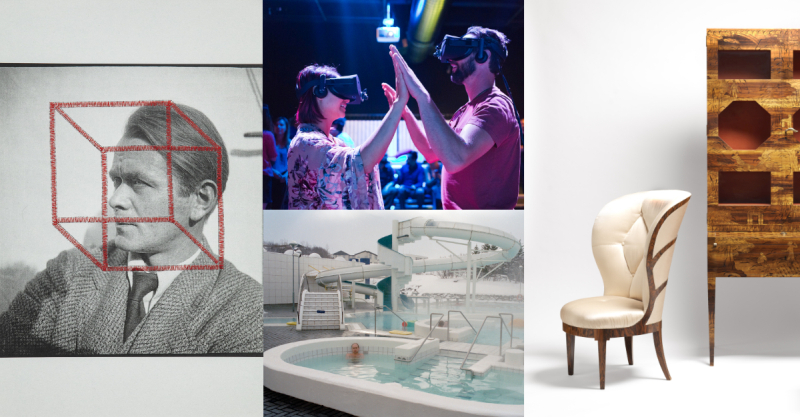5 New Architecture & Design Exhibitions for February 2022
According to the Roman scholar Marcus Terentius Varro February 7th marks the first day of spring.
Which strikes us, as we’re sure it does you, as a little early; however, there was reason in Varro’s bold claim, for Varro further sets February 7th as the start of the year, and for all links February 7th with the rising of the west wind, a favourable, warming wind, whose arrival indicates the need to start cultivating your land and crops, specifically Varro advises, “these are things which should be done in the first period, from the rising of the west wind to the vernal equinox: All kinds of nurseries should be set out, orchards pruned, meadows manured, vines trenched and outcropping roots removed, meadows cleared, willow beds planted, grain-land weeded.”1
But not just the cultivation of your land and crops is important from the rising of the west wind to the vernal equinox, the cultivation of mind and spirit and character is of equal importance.
Our five non-agrarian cultivation tips for February 2022 can be found in Halle, Garðabær, Paris, Stockholm and Zürich…….
“Chairs. Dieckmann! The Forgotten Bauhäusler Erich Dieckmann” at Neuwerk 11, Halle, Germany
There is an argument to be made that the “The” in The Forgotten Bauhäusler Erich Dieckmann should be in bold italics, because, arguably, Erich Dieckmann is The great forgotten Bauhäusler. And a creative whose popular forgottenness somewhat skews not only the Bauhaus (hi)story but the (hi)story of inter-war design in the contemporary Germany. Not least because when Bauhaus moved from Weimar to Dessau Dieckmann stayed in Weimar at the Staatlichen Bauhochschule before moving on to Burg Giebichenstein Kunsthochschule Halle, and in both locations continued his work on, largely, wooden furniture; works that are often more interesting, informative and instructive than the steel tubing that so dominates understandings of inter-War German furniture. And a life, and a contribution to furniture design, ended at the tragic age of just 48, thus allowing similar tragic what if? comparisons with a Hans Gugelot.
Organised by the Kunststiftung des Landes Sachsen-Anhalt and Burg Giebichenstein Kunsthochschule in cooperation with the Staatliche Museen zu Berlin, who will present the exhibition after its run in Halle, Chairs. Dieckmann! is the first Erich Dieckmann retrospective in many a long decade, far too many decades, and promises alongside examples of Dieckmann’s furniture design a presentation of sketches, photos & archive documentation supplemented by works from his contemporaries such as Lilly Reich or Eckart Muthesius and which, should, help elucidate not only what Dieckmann did but for all why he did it, and in doing so help better locate, and fix, Dieckmann on the helix of furniture design than he currently is. And thereby help bequeath Dieckmann the popular, long-term, visibility he currently doesn’t enjoy, but very much deserves. And in doing so should also enable better focussed considerations on his contemporary relevance.
The latter aspect promising to be supported in Chairs. Dieckmann! by contributions from Rudolf Horn and Stefan Dietz on Dieckmann’s influence in post-War design in Germany East and Germany West respectively, through the installation Living like Dieckmann by artist Margit Jäschke and designer Stephan Schulz, and through the parallel showcase Sitzen neu betrachtet at the Burg Galerie which will feature the results of semester projects by Burg Giebichenstein students undertaken in context of Erich Dieckmann.
Chairs. Dieckmann! The Forgotten Bauhäusler Erich Dieckmann is scheduled to open at the Kunststiftung des Landes Sachsen-Anhalt, Neuwerk 11, 06108 Halle on Saturday February 12th and run until Sunday March 27th.
Sitzen neu betrachtet. Entwerfen, beobachten, inszenieren an der Burg, is scheduled to open at the Burg Galerie im Volkspark, Schleifweg 8a, 06114 Halle on Saturday February 12th and run until Sunday March 20th.
Please check the Kunststiftung des Landes Sachsen-Anhalt website and the Burg Galerie website for current information regarding opening times, ticketing and safety/hygiene regulations.
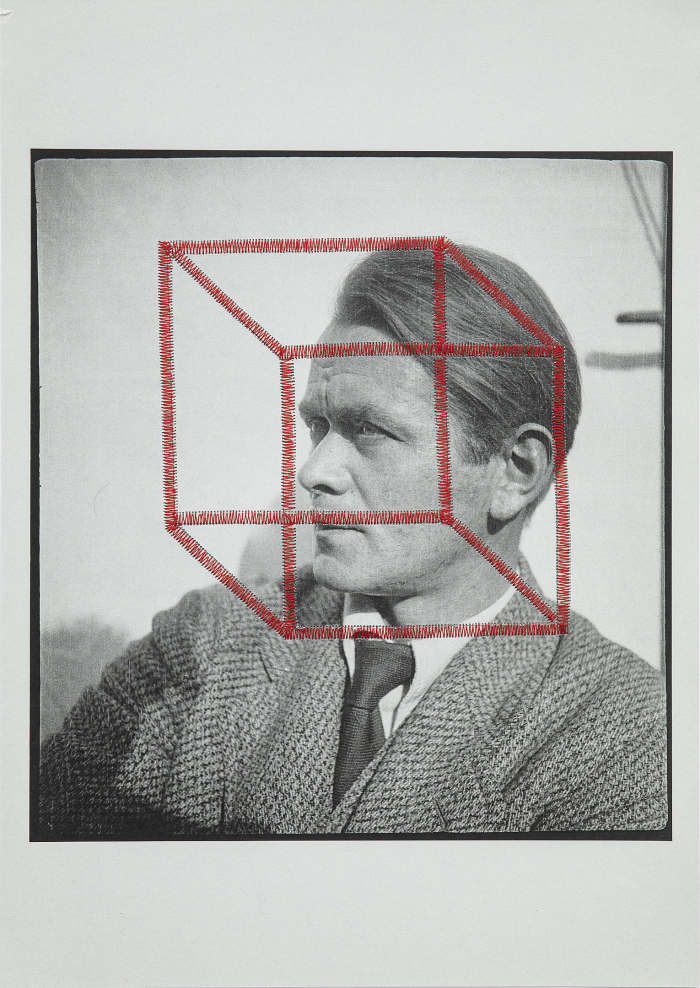
Erich Dieckmann and a cube…. Collage mit Stickerei by Margit Jäschke, (Photo Matthias Ritzmann, courtesy Burg Giebichenstein Kunsthochschule Halle)
“Bathing Culture” at the Museum Of Design And Applied Art, Garðabær, Iceland
As Iceland’s Museum Of Design And Applied Art opine, in Iceland the geothermal pool takes on a similar role to the plaza, the café or the pub in other nations, is a place of private retreat, of public exhibition, of social interaction, are places where the individual becomes an anonymous but valid component of a community, exist as a reflection of the self image of a nation and its peoples. And to which we’d add is something just as easily manipulated as the plaza, the café or the pub by tourism marketeers.
But what is Icelandic bathing culture, how did it develop, who defined, and defines, its contemporary expressions?
Through exploring the contributions of architects and designers of various ilks, and in context of the ever changing social and cultural roles of the geothermal pool since the late-19th century, Bathing Culture sounds as if it should allow one to approach a better understanding of not only the establishment and consolidation of the geothermal pool in Icelandic society since the late-19th century, nor only of the wider developments of 20th century Icelandic society, but also of the inter-relations between cultural/societal developments and architecture/design, the ongoing reciprocal, infrangible, interplay between architects/designers and the communities and societies within which they work. Including, perhaps, allowing allusions to, extrapolations of, those inter-relations, that interplay, in context of contemporary plazas, cafés and pubs.
And which should also allow non-Icelanders to enjoy the geothermal pools of Iceland in a manner more meaningful than that hollow joy promised by the tourist brochures.
Bathing Culture is scheduled to open at the Museum Of Design And Applied Art, Garðatorg 1, 210 Garðabær on Tuesday February 1st and run until Sunday September 25th.
Please check the Museum Of Design And Applied Art website for current information regarding opening times, ticketing and safety/hygiene regulations.
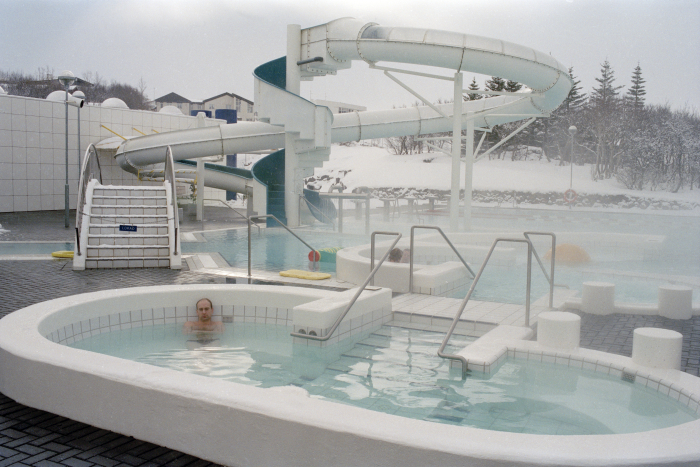
Árbæjarlaug swimming pool Reykjavik (Photo © Gunnar Sverrisson, courtesy Museum Of Design And Applied Art, Garðabær)
“Révolutions Xenakis” at the Musée de la musique, Paris, France
2022 would have seen the Greco-French architect, engineer and musician, Greco-French musician of architecture, architect of music, Iannis Xenakis celebrate his 100th birthday, an anniversary the Musée de la musique will mark with an exhibition that, we’ll argue, should help make the work of Xenakis accessible to a greater portion of society than it, inarguably, currently is.
Having studied engineering in Athens Iannis Xenakis was forced to flee Greece in the late 1940s against the background of the Civil War, and landed in Paris where he found a position as an engineer in the office of Le Corbusier, with whom, as previously discussed, he contributed to projects such as, and amongst others, l’Unité d’Habitation in Marseille or the new city of Chandigarh in northern India, and also developed la bouteille for Le Corbusier’s Poème électronique at the 1958 World’s Fair in Brussels. If a bouteille Le Corbusier was unwilling to publicly acknowledge as Xenakis’, leading to a parting of the ways. Yet before that parting Xenakis had began reflecting on Le Corbusier’s Modulor scale of proportions in context of his own musical compositions, thus initiating an exploration of music, engineering, maths and architecture that saw Iannis Xenakis developing into one of the more interesting, if not necessarily more instantly accessible, composers of the second half of the 20th century.
Promising a tour through, or perhaps better put, a spin through, Xenakis’ work in 6 short chapters covering subjects such as his Polytopes, his relations to fledgling computer technology, or his, not Le Corbusier’s, his Philips Pavilion, Révolutions Xenakis should help introduce a creative who arguably more than any other helps one understand music as architecture and architecture as music, to approach differing comprehensions of the construction of space that are inherent components of both, of both being as much of math as of intuition, and of the relationships between the aesthetics of architecture and the aesthetics of music. And just because aesthetics is subjective, doesn’t mean it can’t be studied objectively, and thereby, potentially, hopefully, better appreciated.
Révolutions Xenakis is scheduled to open at the Musée de la musique – Cité de la musique, 221, avenue Jean-Jaurès, 75019 Paris on Thursday February 10th and run until Sunday June 26th.
Please check the Musée de la musique website for current information regarding opening times, ticketing and safety/hygiene regulations.
Iannis Xenakis, Metastaseis, 1955 (via Boosey & Hawkes and performed by Arturo Tamayo and Orchestra Sinfonica RAI) If you’re unfamiliar with it, it does start very, very quietly, but builds, so take care with the volume control……
“Swedish Grace. Art and Design in 1920s Sweden” at the Nationalmuseum, Stockholm, Sweden
1920s Europe is and was, arguably, one of the least easily definable and least tangible of all decades. And also one of the most important: that post-War decade that saw, again arguably, more political, social, economic and cultural change than any before it, a post-War decade that saw advances and retrogressions move hand in hand with an untroubled ease; and a post-War decade that shortly after it ended, became a pre-War decade whose advances and retrogressions suddenly stood in a completely different light.
And whereas elsewhere in Europe the 1920s were Roaring or Golden or folle, in Sweden the 1920s were graceful.
Or were considered so in retrospect, the phrase Swedish Grace arising in 1930 as a lament by the British architecture critic Philip Morton Shand that the Swedish had lost the Grace their architecture and applied art and design had enjoyed in the 1920s.
If they had is naturally a subjective matter, but one Swedish Grace at the Nationalmuseum should allow plenty of opportunity for reflection on, promising as it does a fulsome presentation of design, art, clothing, photography and cinema from 1920s Sweden which should provide not only for concentrated explorations of creativity in Sweden in that most volatile of decades, nor only better understandings of Swedish society and Sweden’s relationships with the rest of the world in that most volatile of decades, but also allow one to better appreciate the (hi)story of the development of art and design in Sweden in context of Swedish society and Sweden’s relationships with the rest of the world.
Swedish Grace. Art and Design in 1920s Sweden is scheduled to open at the Nationalmuseum, Södra Blasieholmshamnen 2, 111 48 Stockholm on Thursday February 24th and run until Sunday August 28th.
Please check the Nationalmuseum website for current information regarding opening times, ticketing and safety/hygiene regulations.
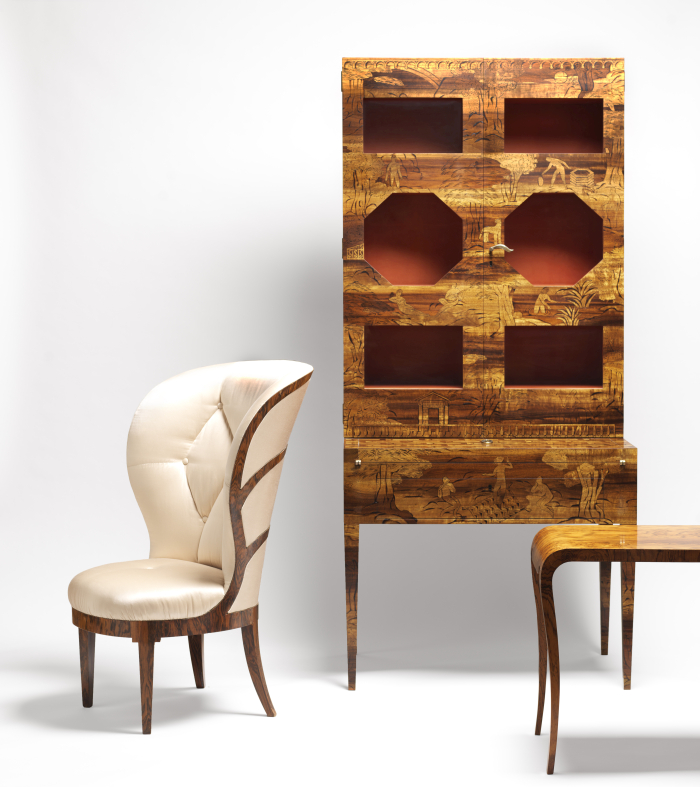
The Cabinet “Paradiset” from 1924, and a 1925 chair and table by Uno Åhrén for Mobilia AB, part of Swedish Grace. Art and Design in 1920s Sweden, Nationalmuseum Stockholm (Photo © and courtesy Nationalmuseum Stockholm)
“Planet Digital” at the Museum für Gestaltung Zürich, Switzerland
Although we all regularly speak of “digitalisation” and a “digital world” what does that actually mean? Not necessarily in context of actual objects and processes and rituals but in terms of the social, cultural and environmental consequences, impact, of ever increasing digitalisation?
By way of attempting to approach possible answers students from the Universität Zürich, the Zürcher Hochschule der Künste and the Zürcher Hochschule für angewandte Wissenschaften teamed up with international creatives of varying hues to explore questions such as, and amongst many others, the realities of mining for the necessary rare earths digitalisation requires, the maths behind algorithms and questions of the fairness, or otherwise, thereby achieved, or how digital technology is enabling new possibilities in ecological research, and where that could lead us. In addition Planet Digital will present examples of art produced by digital systems and digital means which, should, enable alternative perspectives on the many questions raised by the topics involved, and thereby on our relationships with developing digitalisation.
Promising a multi-medial presentation over a parcour of some 25 installations Planet Digital should allow not only for differentiated perspectives on the pros and cons of increasing digitalisation, of the challenges, opportunities, rewards and pitfalls of embracing ever more digital technology, but for all should help us all acquire a few more of those tools that are so necessary in enabling us to make better judgements on how our future relationships with digital technology should be defined and constructed.
Planet Digital is scheduled to open at the Museum für Gestaltung Zürich, Ausstellungsstrasse 60, 8005 Zürich on Friday February 11th and run until Monday June 6th.
Please check the Museum für Gestaltung Zürich website for current information regarding opening times, ticketing and safety/hygiene regulations.
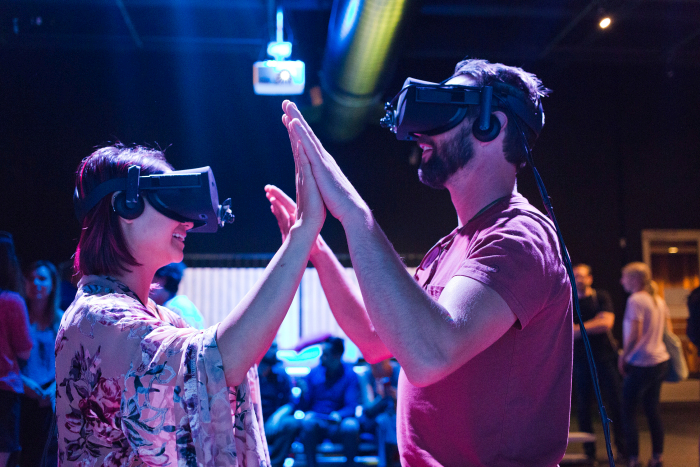
BeAnotherLab, The Machine to Be Another : Body Swap, part of Planet Digital, Museum für Gestaltung Zürich (Photo © NonFiction Media, courtesy Museum für Gestaltung Zürich)
1. Marcus Terentius Varro, De Re Rustica, Loeb Classical Library, 1934 available via https://penelope.uchicago.edu/Thayer/E/Roman/Texts/Varro/de_Re_Rustica/1*.html (accessed 31.01.2022)
Tagged with: Bathing Culture, Bauhaus, Berlin, Burg Giebichenstein, Chairs. Dieckmann!, Erich Dieckmann, Garðabær, Halle, Iannis Xenakis, Iceland, Kunststiftung des Landes Sachsen-Anhalt, Le Corbusier, Musée de la musique, Museum für Gestaltung, Nationalmuseum, Paris, Planet Digital, Révolutions Xenakis, Staatliche Museen zu Berlin, Stockholm, Swedish Grace, Weimar, Zürich
